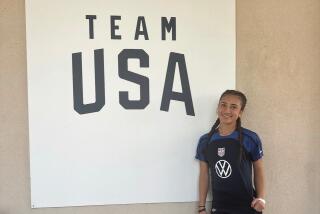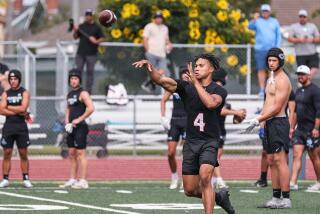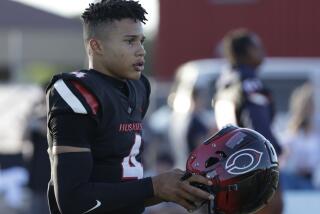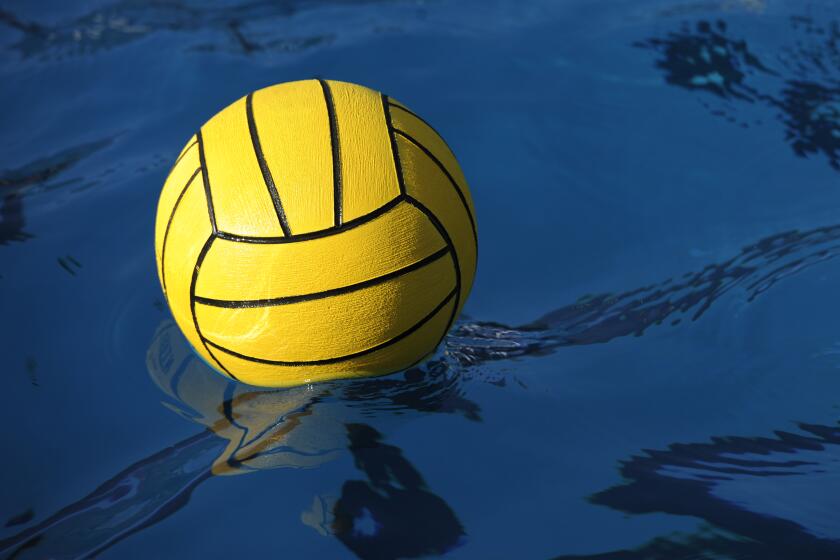Coaches’ Task: Winterizing Fall Athletes : High schools: Some make the change from football, wrestling and volleyball to basketball easily. Others find it much more difficult.
Tim Manning and Jim Farbaniec didn’t have much time to celebrate after helping Trabuco Hills High School win the Division VIII football championship in December.
One day after the Mustangs beat Orange, 13-7, for their second consecutive Division VIII title, Manning and Farbaniec were back in uniform.
Basketball uniforms, that is.
Manning, a quarterback and a defensive back, threw for a touchdown and intercepted a pass in the Friday night football championship game.
Twenty-four hours later, he came off the bench and played 15 minutes, scoring two points in a 67-64 victory over Mission Viejo in the third-place game of the Trabuco Hills tournament.
It wasn’t a great performance for Manning, who scored 15 and 17 points in games the next two weeks, but it was a start.
“Jim and I went out there, looked at each other and laughed,” said Manning, a 6-foot, 180-pound senior. “We couldn’t believe we were doing this. We had just won CIF and we were still thinking football.”
Manning and Farbaniec are among several Orange County high school athletes who make the transition between fall and winter sports.
Some, such as Manning, make the transition easily. Others have difficult, even painful experiences.
Farbaniec didn’t play against Mission Viejo and was used as a substitute the next few weeks. He was still struggling to learn all of the Mustangs’ plays.
“We had just won the football championship and I was ready to celebrate,” said Farbaniec, a 6-4, 260-pound offensive and defensive tackle. “But there I was going out and running drills for basketball. It was kind of tough for the first few days.”
The transition can be particularly frustrating for basketball coaches.
They sometimes struggle early in the season because their best players are playing football or volleyball. And, once the players do arrive, their shots often draw iron but no net.
Rainer Wulf, Trabuco Hills basketball coach, said he encouraged Manning and Farbaniec to play football. But their absence early in the basketball season caused problems.
“The positive is that they’re doing well in another sport, then come in here after winning the CIF championship and they’re really pumped up,” Wulf said. “It injects some energy back into the team.
“But we had to wait to put in some of our presses and things we do offensively until Tim got here. They wouldn’t work without him in there.”
The late arrivals sometimes create frustrating practices.
Dan Henshall, girls’ basketball coach at El Dorado, has four volleyball players on his team. He spends the first few weeks of practice working with them on rebounding.
“They’re used to tipping the ball instead of shooting it,” he said. “I keep reminding them to catch the ball.”
Charlie Brande, girls’ volleyball coach at Corona del Mar, said most volleyball players sit out the basketball season to compete for club volleyball teams.
“Because there are so many volleyball scholarships available, it’s more attractive for them to specialize (in volleyball),” he said. “That’s wrong. We try to work our club season around so they can play basketball too.”
Although Manning’s football and basketball seasons overlapped, he had few problems adjusting. He is in his third year of varsity basketball and had played during the summer, so he picked up the offensive plays right away.
“I still wasn’t the player I was last summer,” he said. “I was averaging 24 or 25 (points) last summer.”
It was even tougher for Farbaniec, who sat out the basketball season as a junior to concentrate on academics and train for the shot put and discus events in the upcoming track season.
“Jim had taken a year off from basketball (so) he had to relearn everything,” Wulf said. “It took a couple of weeks before I could call a play and he wouldn’t look at me like, ‘Uh oh, what was this one?’ ”
Trabuco Hills had a two-week break in its schedule after playing in the San Dieguito tournament in mid-December. Manning said the break has provided a chance to get comfortable with the Mustangs’ offense.
“We’re getting everything burned back into our minds,” Manning said.
Athletes make more than a physical transition, though.
Trevor Cooper of Huntington Beach said the transition from football to wrestling was a demanding one physically and mentally.
Cooper, a nose guard who wrestles in the 191-pound class, separated his shoulder during football practice last fall. He reinjured it in a wrestling meet in mid-December and sat out three weeks.
“Making the transition was a big deal,” Cooper said. “There was a lot of pressure with football, and the break (in wrestling season) helps. The hunger starts to come back, but it’s still hard to be out.”
Conditioning plays a big part in making the transition from sport to sport, coaches say.
Henshall said his volleyball players came to basketball practice in good shape, but still had room to improve.
“It’s not too bad of a transition,” he said. “I don’t find too many problems. It’s harder to go from a sport like basketball to track and field.
“There you’re going from an anaerobic sport to an aerobic sport, and from a team sport to an individual sport.”
Jim Reames, boys’ basketball coach at Foothill, said football players make “much more aggressive basketball players than regular basketball players.”
“Physically, they’re tougher,” he said. “But conditioning-wise, they still need to get their basketball legs back.”
Wulf said most football players have trouble playing a full 32 minutes of basketball when they initially make the switch.
“They’re in long-term shape but not in basketball shape,” Wulf said. “We ask them to go hard 30 or 40 seconds and then get a few seconds break. In football, it’s just the opposite.
“You notice it especially if the player’s a shooter. Tim’s (Manning) shots all hit the front of the rim that first week he was back. His legs weren’t in the type of shape to get high enough on his jump shot.”
Manning said: “You have to get in shape or your legs die really quick. Everything was moving in fast-forward ahead of me. I was confused trying to remember plays. You may look ready but still thinking, ‘Yeah I’ve a long way to go.’ ”
In contrast, volleyball players make the switch to basketball with few problems, rebounding notwithstanding, Henshall said.
Henshall said the similarities between volleyball and basketball make the transition easier.
“We have a conditioning program for basketball, but I would prefer they go out for volleyball,” Henshall said. “They do a lot of jumping and lateral movement in volleyball and that really helps them (for basketball). And they’re working on the timing of the ball coming to them.
“It helps on defense too. (In volleyball) they’re always helping out on defense, just like basketball. You get an assist in volleyball, just like basketball.”
The transition between sports can be a little confusing. At least Manning believes so.
“By the San Dieguito tournament (mid-December), I felt more like a basketball player instead of a football player trying to play basketball,” he said.
More to Read
Get our high school sports newsletter
Prep Rally is devoted to the SoCal high school sports experience, bringing you scores, stories and a behind-the-scenes look at what makes prep sports so popular.
You may occasionally receive promotional content from the Los Angeles Times.






